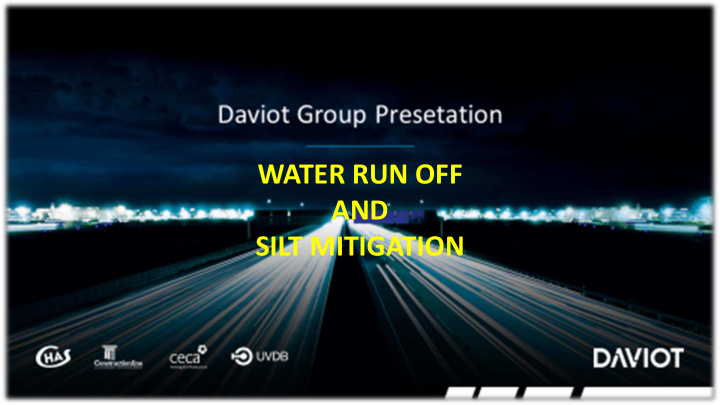



WATER RUN OFF AND SILT MITIGATION
THIS PRESENTATION IS TO SHOW THE BASICS OF RUN OFF CONTROL AND SILT MITIGATION IN PARTICULAR WHERE YOU HAVE A NARROW AND RESTRICTED WORK AREA
WATER MANAGEMENT ON SIT SITE DO NOT ALLOW: 1. Dirty water to enter clean 2. Water from the site to discharge into any water courses or drains without primary and secondary mitigation 3. Any contaminated water to enter neighbouring land 4. Yourself to ignore any potential or actual environmental incident! ALWAYS: 1. If Pumps are installed Check for leaks 2. Act, where you can, should you see any contamination occurring 3. Report to your line manager/supervisor any environmental concerns you may have 4. Be aware of any CAR registered water courses on site 5. Be aware of any areas which have a designation eg SSSI 6. Ensure any pumps, silt bags, soil bunds or any other mitigation is 10M or more from any open ditch or watercourse
SOURCES OF F CONTAMINATION • Silt • Fuel Leaks • Hydraulic fluid leaks • Concrete seepage • Bentonite spillage • Broken field drains • Litter • Poor management of silt bags • Poorly installed silt fencing
SIL SILT • Fine sand, clay, or other material carried by running water • Silt washed off construction sites into nearby watercourses and drains can lead to blockages and flooding • It is the biggest cause of pollution incidents during construction • It can lead to killing fish, plants and other life due to restricting oxygen levels and removing sunlight • It is illegal to allow silt to enter a water course or drain. Silt pollution is easily traceable to the origin. • This has been a major cause of prosecution
TOOLS FOR MIT ITIGATION 1. Silt Fencing installed correctly 2. Straw Bales 3. Install drainage ditches 4. Install Sumps 5. Use holding pools 6. Use washed stone 7. Pumps with silt bags + Silt fencing 8. Vegetation - natural filtration 9. Silt buster – if space allows 10. Follow the CEMP
WHATS WRONG HERE?.... 1. Not 10M from an open watercourse 2. Silt fence incorrectly installed 3. Best practice would mean a further level of mitigation eg second silt fence installed – this is missing here
CAITHNESS AND MORAY HV CABLE INSTALLATION
THE BOWL INCIDENT
SIL ILTY WATER ENTERING OUR SIT ITE FROM THE BOWL WORKS
1. . SHOWS DRA RAINAGE DIT ITCH INS INSTALLED AND WORKING TAKI KING TH THE E WATER AWAY 2. . INS INSTALLED CULVE VERT TAKI KING TH THE E RU RUN OFF AWAY FR FROM OUR R WAYLEAVE BUT T WATER VE VERY SIL ILTY
IN INITIAL LESSONS LEARNT FROM THE BOWL IN INCIDENT 1. ENSURE ANY DESIGN CONSIDERS ANY ADJACENT DEVELOPMENTS 2. ARRANGE SITE MEETINGS WITH ADJACENT DEVELOPMENT TO ENSURE JOINED UP THINKING AND AGREED JOINT MITIGATION. 3. ONCE CONTAMINATION IS IDENTIFIED ENSURE SEPA IS CONTACTED IMMEDIATELY
GENERAL LESSONS LEARNT 1. Ensure all drainage and dewatering designs are completed pre construction 2. Make sure the above designs are installed prior to any works commenced 3. Establish environment teams on site sufficient to cover the area of work 4. Silt bags must be checked and maintained regularly during the day 5. Tool box talks on water contamination and silt management must be carried out on a regular basis 6. Emergency response training should be carried out at regular intervals to allow for any staff turnover 7. Always apply the 10M rule as recommended by SEPA 8. Make sure all land agreements for the placement of any mitigation outside of your legal work area have been agreed prior to works commence 9. Always be ready to change and adapt any drainage designs as what happens on paper doesn’t always meet what happens on the ground!
Recommend
More recommend